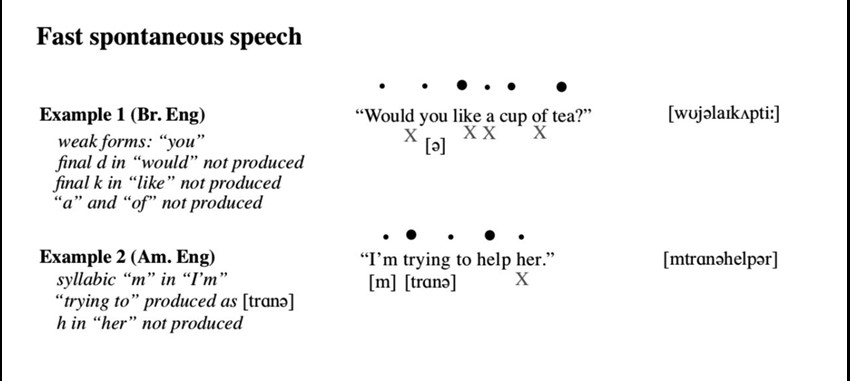Beyond comprehension
by Emma Gowing
How effectively do we really teach listening? Researchers and material writers such as Field and Cauldwell have been addressing the deficiencies of common approaches to listening for some time. But how accessible is this research to newer teachers? In this article I summarise some of the prominent theory and research into L2 listening as well as reflect on my recent experiences and experiments in the classroom. Finally, I propose some classroom tools and activities that can help us rethink and refresh our approach to listening.
The theory
Much has been said and written about teaching listening in the classroom. However, despite the wealth of information available to us on this subject, it still remains an area of ELT that few teachers will have had access to or training in until they reach Delta or Master’s level — and sometimes even then it can be overlooked in favour of other skills! Meanwhile, it remains one of the aspects language learning that many say they find most difficult. Ever heard your learners bemoan how fast L1 speakers talk after a recent trip to an Anglophone country? If so, read on...
So, where does the problem lie? For a start, coursebooks often use texts that are inauthentic and highly graded and only reflect a very limited range of listening encounters. Therefore, learners’ exposure to natural, spontaneous speech is extremely restricted, particularly for those learning English as a foreign language. Furthermore, most coursebooks and initial teacher-training courses tend to adopt what Field calls ‘the comprehension approach’ (CA) whereby the teaching of listening takes the form of simply exposing our learners to listening texts and testing how much they understand using comprehension activities.
Let’s look at a typical classroom procedure for listening that most of us would be familiar with:
Pre-listening
- Warmer — establish context of listening and/or create motivation with prediction
- Pre-teach task-blocking lexis in text/task (optional)
During listening
- Gist listening — a simple comprehension task to get an overall view of the text and/or check predictions
- Detailed listening — typically a multiple-choice, True/False or comprehension question activity to establish more detailed understanding
Post-listening
- Related speaking or writing task related to text
and/or - Language work from text
I don’t deny the well-established benefit of activities that activate prior knowledge (schema) and help the learner build meaning through context — tasks frequently described as top-down processing. But at what point in this model are we teaching listening skills? While comprehension activities can show us what aspects of a text a learner understands, how useful is it for identifying and working on those aspects of the listening that they don’t? As Field argues, the CA focuses primarily on the product of listening in the form of answers to questions, but fails to provide any insight into the processes by which that answer was reached (Field 2009: 81). Processes that often fall by the wayside in this approach are those that require decoding — those bottom-up processes that are particular to listening such as hearing sounds on a phoneme level, recognising where words begin and end in connected speech, recognising stressed and weak words, recognising intonation patterns, etc.
We can conclude, perhaps, that modern teaching of listening is lacking in two significant things: exposure to a variety of authentic listening texts and training in decoding processes. The former is more easily resolved as there are plenty of materials out there if we look. The latter less so. ‘But I teach my learners about connected speech!’ I hear you cry. However, when we do attempt to turn our learners’ attention to features of connected speech that can make listening challenging, we usually do so using what Cauldwell describes as ‘the careful speech model’ (Cauldwell 2013:0.8). Consider the following sentences:
These sentences follow generally accepted rules of connected speech, such as stress, weak forms, assimilation and elision. A useful model, particularly for emulation and production and eminently teachable. However, consider this next pair of examples:


These are examples (transcribed from real speech) of what a learner might actually hear ‘in the wild’– with even more irregularities and regional accent variations. While we might not want to teach these as a model for production, raising awareness of the kinds of unfamiliar sound shapes demonstrated in this second example might be more effective in terms of improving our learners’ ability to hear and decode fast, spontaneous speech. This doesn’t necessarily require an in depth knowledge of phonology, we just need to find authentic examples, listen more carefully and go beyond the careful speech model using features of connected speech we/they are already aware of.
In summary, what is necessary is an approach to listening that bears in mind all of the above, that exploits the typical comprehension cycle such that it can be used as a diagnostic tool to find out where learners’ weaknesses and difficulties lie and then supplement it with remedial activities that focus on decoding processes. But how exactly? What follows is how I went about this with my learners’ as well as some materials and resources I have found useful.
A case study
The learners: A group of adult, Argentinian learners at an Advanced level. They are very effective readers and can understand and apply critical thinking skills to a wide range of printed texts. Despite this, their skills with reading comprehension did not transfer to effective listening comprehension and they frequently complained that they felt they couldn’t understand proficient speakers while on holiday and even in podcasts and TV. A lot of the teacher training I had received up until then had seemed to conflate reading and listening skills into similar ‘receptive skills’ approaches, but it was this group that encouraged me to question this and find out more about processes that were particular to listening in order to help them.
The needs analysis: We discussed specific situations in which they had experienced listening difficulties. From a list of potential causes, they then identified why difficulties arose. Overwhelmingly, they said that they felt their difficulties were related to the speed of speech, the speaker’s accent and words seeming to run together in the stream of speech.
The diagnostic tests: In order to confirm the results of the needs analysis, we did a listening comprehension with an authentic text. Afterwards, learners’ looked at the audio script and identified parts they had missed or misinterpreted. We discussed reasons why those parts might have been difficult. I was able to identify that any issues were not related to the language as they understood everything they read in the audio script. In a subsequent class, I tested them on specific decoding processes by using short recorded dictations of fast spontaneous speech and asking them to complete the following activities: writing the last word they hear in a sentence, counting the number of words in a sentence, and identifying appropriate contrastive stress by marking the correct response to question. They found these activities far harder than the comprehension exercise and it was evident that their difficulties lay with hearing and decoding the stream of speech and not, as suspected, with the language itself.
As a result of these initial explorations, I was better able to look for materials and resources to supplement my usual listening practice, address the specific difficulties of my learners and add a little variety into the usual comprehension cycle. By the end of the year, they were telling me how much more confident they felt with listening outside the classroom!
Here are some ideas and resources that I have found useful to this end:
Activities & resources
- Firstly, there is no need to abandon the CA entirely but try to move away from questions that have clear right/wrong answers. Encourage learners to build meaning independently by taking notes, comparing/contrasting, putting events in order, etc. Get them working in pairs and groups with minimal teacher intervention to build their autonomy. This also leaves you free to take notes and pay attention to the areas of difficulty for subsequent remedial focus.
- Use the audio script after comprehension activities to encourage learner noticing and help you diagnose listener difficulties — was the difficulty language or hearing related?
- Use authentic materials and vary the types of listening to encourage listeners to become flexible (grade the task, not the text). One of the coursebooks I have found helpful is Keynote from National Geographic/Cengage which uses TED talks even for lower levels and also has useful ‘authentic listening skills’ activities. Speak Out from Pearson also uses authentic texts from BBC radio and television.
- Dictagloss: dictate or play short parts of text to learners and ask them to transcribe what they hear, building up slowly over multiple listens, beginning with stressed content words and chunks and progressing to unstressed, more grammatical words. Show them the audio script and compare their answers. Encourage them to identify areas of difficulty and possible causes and raise awareness of phonological features that make speech difficult focusing on stress, elision, sound changes, linking, etc.
- Create your own (semi) authentic audio. Use your colleagues and friends as a resource and record parts of unscripted conversation. Transcribe these and make your own activities which focus on features of natural spontaneous speech such as redundancies, hesitations and fillers.
- Make use of different accents available to you and invite colleagues or friends into the classroom for live listening e.g. story-telling or interviews. This can be especially useful to provide them with participatory listening & speaking practice.
- Where colleagues are exhausted or unavailable, check out www.dialectsarchive.com where you can find both audios and transcriptions of proficient speakers of English from all over the world. Not only is it fascinating to plumb the depths of the multitude of accents (everyone loves an accent!), it can also help raise awareness of the sheer quantity of global Englishes. The audios can be used for both comprehension and decoding activities.
- Use a Listening log to promote independent listening outside of class. Learners listen to podcasts, radio/TV shows, you tube videos, etc., and summarise what they hear, take notes on parts they found difficult, reflect on why and draw from a list of strategies to motivate and avoid frustration (contact me if you want a ready-made version!).
- We often talk about doing micro-writings and even micro-readings, why not micro-listening? Expose learners to short sections of dense connected speech, especially featuring elements already identified as difficult. Experiment with activities such as gap fills, identifying stressed syllables or words, counting the number of words they hear, writing the last word they hear in an utterance, identifying intonation patterns etc.
- For some interesting pre-made micro-listening activities using fast spontaneous speech, see Caudwell’s free resource materials Jungle Listening at www.speechinaction.org/jungle-listening-survival-tips-for-fast-speech/
I hope you found this article useful and happy listening! Feel free to contact me for any further information about any of the techniques or activities I have mentioned.
|
References: Cauldwell, Richard (2013). Phonology for Listening. Birmingham: Speech in Action Cauldwell, Richard (2013) Jungle Listening: High and Low Tech Approaches to Teaching the Stream of Speech, Available at: https://www.viddler.com//v/55aebec7/ Accessed: 20/9/2019 Field, John (2008). Listening in the Language Classroom. Cambridge: CUP |
 |
Author's bio: Emma Gowing is currently Director of Studies and a CELTA tutor at IH Buenos Aires but is relocating to IH Santiago de Compostela in January to assume the position of Academic Manager and Head of Teacher Training. She is passionate about teacher training and fostering a positive learning environment for students and teachers alike. She is particularly interested in phonology for listening and raising awareness of the global nature of English through the use of authentic materials. This is her first journal article but hopefully, the first of many. |
